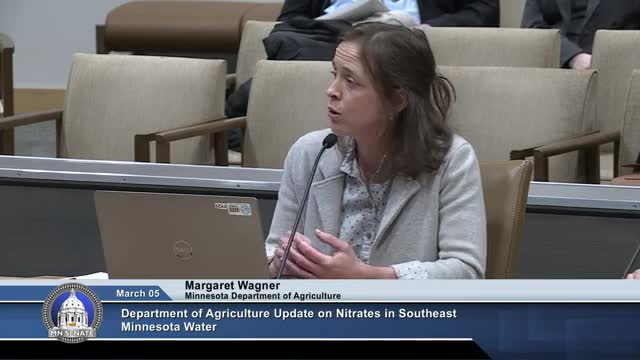Minnesota invests in irrigation specialists and weather stations to combat nitrate pollution
March 05, 2025 | 2025 Legislature MN, Minnesota
This article was created by AI summarizing key points discussed. AI makes mistakes, so for full details and context, please refer to the video of the full meeting. Please report any errors so we can fix them. Report an error »

The Committee on Agriculture, Veterans, Broadband and Rural Development convened on March 5, 2025, to discuss various initiatives and funding related to agricultural practices and water quality in Minnesota. The meeting highlighted the ongoing collaboration between the Department of Agriculture, local communities, and educational institutions to enhance agricultural sustainability and address water quality concerns.
The session began with a discussion on the importance of on-farm trials and the role of irrigation specialists in supporting farmers. The committee emphasized the significance of science-based research in guiding agricultural practices. A representative noted that funding has been allocated to ensure that these specialists are available through university extension services, which has helped build robust programs across the state.
A key topic of discussion was the groundwater protection rule, which categorizes communities based on nitrate levels in their public water supply. Communities with nitrate levels between 5.4 and 8 parts per million are classified as Level 1, while those exceeding 8 parts per million fall into Level 2. The committee acknowledged the presence of several communities within these classifications and discussed collaborative efforts with local soil and water conservation districts (SWCDs) to address these issues.
Senator Anderson raised concerns regarding funding adequacy from the Agriculture Department. Commissioner Peterson responded affirmatively, expressing gratitude for the financial support received, particularly from the Clean Water Fund. He highlighted successful programs funded through this initiative, including soil health equipment grants and the Ag Best Management Practices (BMP) loan program, which provides revolving loans to counties for agricultural improvements.
The meeting also addressed the expansion of weather stations across Minnesota, funded by the Clean Water Fund. This initiative aims to enhance farmers' access to critical weather data, thereby improving agricultural decision-making. The committee noted that $3 million has been allocated to establish 70 new weather stations, which will benefit farmers and researchers alike.
In conclusion, the meeting underscored Minnesota's commitment to addressing agricultural challenges and improving water quality through collaborative efforts and strategic funding. The committee expressed optimism about the state's leadership in tackling nitrate issues, while also acknowledging the need for continued financial support to sustain these initiatives.
The session began with a discussion on the importance of on-farm trials and the role of irrigation specialists in supporting farmers. The committee emphasized the significance of science-based research in guiding agricultural practices. A representative noted that funding has been allocated to ensure that these specialists are available through university extension services, which has helped build robust programs across the state.
A key topic of discussion was the groundwater protection rule, which categorizes communities based on nitrate levels in their public water supply. Communities with nitrate levels between 5.4 and 8 parts per million are classified as Level 1, while those exceeding 8 parts per million fall into Level 2. The committee acknowledged the presence of several communities within these classifications and discussed collaborative efforts with local soil and water conservation districts (SWCDs) to address these issues.
Senator Anderson raised concerns regarding funding adequacy from the Agriculture Department. Commissioner Peterson responded affirmatively, expressing gratitude for the financial support received, particularly from the Clean Water Fund. He highlighted successful programs funded through this initiative, including soil health equipment grants and the Ag Best Management Practices (BMP) loan program, which provides revolving loans to counties for agricultural improvements.
The meeting also addressed the expansion of weather stations across Minnesota, funded by the Clean Water Fund. This initiative aims to enhance farmers' access to critical weather data, thereby improving agricultural decision-making. The committee noted that $3 million has been allocated to establish 70 new weather stations, which will benefit farmers and researchers alike.
In conclusion, the meeting underscored Minnesota's commitment to addressing agricultural challenges and improving water quality through collaborative efforts and strategic funding. The committee expressed optimism about the state's leadership in tackling nitrate issues, while also acknowledging the need for continued financial support to sustain these initiatives.
View full meeting
This article is based on a recent meeting—watch the full video and explore the complete transcript for deeper insights into the discussion.
View full meeting
